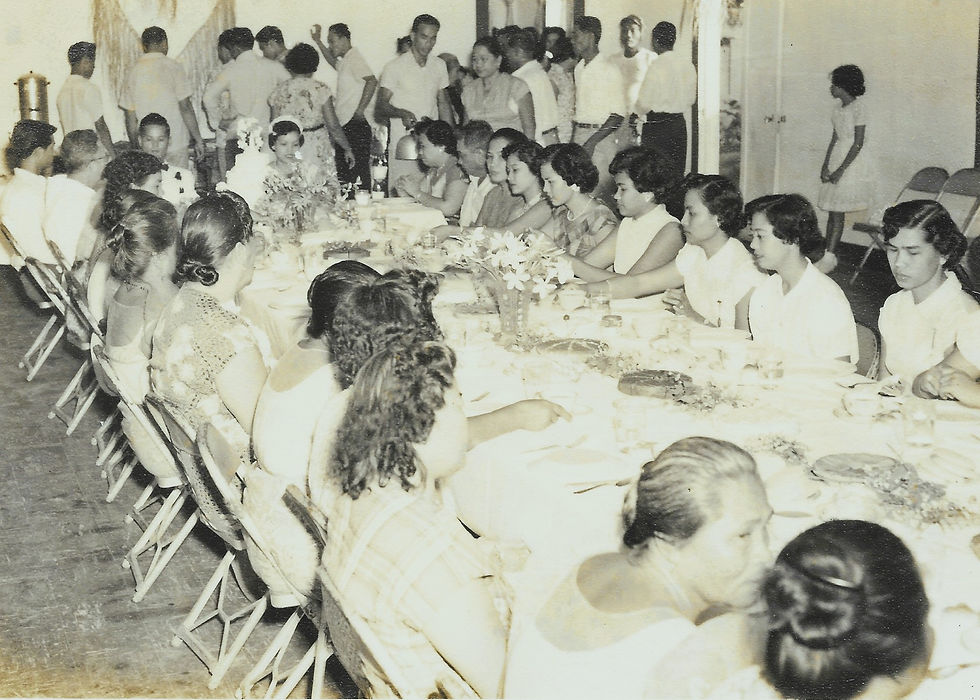Don’t skirt the women who championed the Organic Act of Guam
- Admin

- Aug 29
- 4 min read


The recent commemoration of the 75-year-old Organic Act of Guam, along with the daily media coverage, made no mention of the women who helped push the matter forward.
More than a few women—educators, community and church organizers, business owners and political pioneers—played a significant role in advancing the drive for some semblance of self-government for the people of Guam after liberation from wartime occupation.
They had suffered the atrocities of war, yet remained hopeful and prayerful until American military forces arrived to reclaim our island from enemy forces.
They traveled far and wide to learn the ways of the postwar world, returning home to apply their knowledge and help rebuild the island’s social and economic infrastructure. They also sewed the fabric that clothed the men who journeyed to the U.S. capital to seek a fair and just system of governance for Guam.
Agueda I. Johnston endured the wartime occupation as a teacher and patriot. Although her husband, Lt. William G. Johnston, was imprisoned in Japan a month after the invasion and eventually died there, she helped stitch together the CHamoru people during that oppressive period.

She is listed in the first “I Manfayi: Who’s Who in Chamorro History,” a four-volume Hale’-ta book series featuring biographies of prominent figures in Guam’s history.
The entry on Johnston notes: “Along with several other prominent and respected community leaders, she was often invited to listen to the radios operated secretly… then passed along the latest information about the progress of the war.”
She resisted Japanese interrogation to the point of being beaten for suspicion of aiding the U.S. Navy holdout, radio man George R. Tweed.
After the war, Johnston became principal of the newly established George Washington High School. She dedicated 46 years to educating CHamoru youth, leaving a profound and lasting impact on CHamoru society. Following her death in 1977, the reorganized Guam Department of Education dedicated the newer GW junior high school in Ordot in her name. Today, it is known as the Agueda Iglesias Johnston Middle School.

Concepcion “Chong” C. Barrett was another teacher, a Guam Congress assemblywoman and a postwar senator in the legislature. She was also an entrepreneur who operated a dress shop. During one of her buying trips to the states, she traveled to Washington, D.C., where she testified before the U.S. Congress on the draft Organic Act.
“We hope for enactment of the organic legislation without delay… You have the power to give us the democracy which America is defending all over the world,” guampedia.com quotes her as saying.
Into the 1960s, she helped form the Republican Party of Guam and won seats in the 11th and 13th legislatures. Rising to the position of party leader, she also served as a member of the Republican National Committee.
Many other matriarchs of those postwar years included Ignacia B. Butler, the founder of Guam’s oldest business, and beloved nurse Amanda G. Shelton. In politics, pioneers included Rosa A. Reyes, the first woman to serve in the Guam Congress (1946–1950), representing Merizo. The first women elected to the 21-seat Guam Legislature were Lagrimas L.G. Untalan and Cynthia J. Torres.

My mother, nee’ Dorothea L. San Nicolas, so took part in the concerted push for human and political rights for the CHamoru people. She started her career with the First Guam Legislature, serving as one of its two secretaries—executive and legislative.
After the war, she pursued her education in San Francisco, the younger of two daughters who survived the Japanese invasion; her only brother and another sister did not. Her widowed mother also survived, thanks to the care of CHamoru nurse/midwives and family members who helped her heal from eight stab wounds to her upper body. My grandmother had been bayoneted and left to die during the 1941 Japanese invasion landing at East Hagåtña, known as the Trinchera Massacre.
While in California, my mother lived with Grandma’s brother and a male first cousin who was studying airplane design and engineering. Many families likewise sent their daughters and sons off to the states for post-secondary studies.
For more than 70 years, Mom kept a gray-covered amended copy of the 1950 Act among other precious items in her “forever files.” It remains nearby, as treasured as gold.
A few years after starting her career at the legislature, Mom was hired to work with Attorney Joaquin C. Arriola at his private firm, the oldest on Guam. She left the legal office in the mid-70s to care for her sickly mother, but never stopped encouraging me to pursue justice for the CHamoru people, as promised in the 1950 congressional pact.
Forty years later, I worked with the Nasion CHamoru to see through the implementation of the CHamoru Land Trust Act, for fair treatment of the indigenous people of Guam under international law, and for self-government in its most radical form, which is independence.
Through those decades, I sensed my mother’s understanding and support, though she rarely verbalized any affinity for our more recent activism in its raw form.
To this day, as with our first female governor and many other women serving in positions of authority and weighty consequence, our CHamoru matriarchs bind us all to the quest for rightful recognition and respect for Guam’s people. Biba famalao’an!
Jan S.N. Furukawa is a longtime journalist, editor, independent publisher and educator. She is a co-founder and sales & marketing executive of the Pacific Island Times.

Subscribe to
our digital
edition





